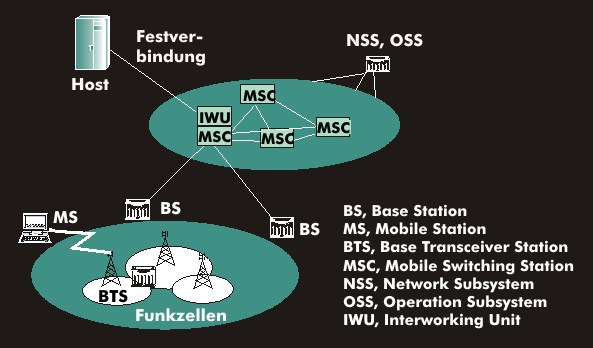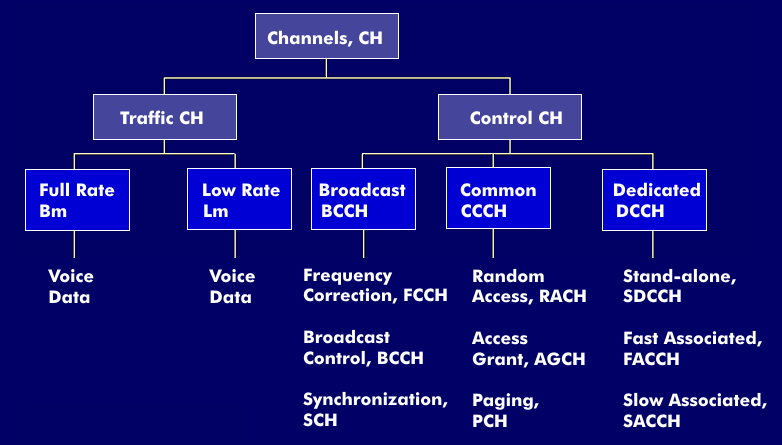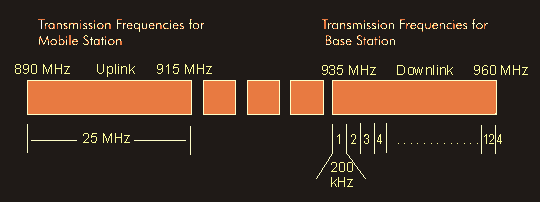GSM network
In Germany, the GSM standard is used in the digital, circuit-switched mobile communications networks "D" and "E." The GSM network has been in regular operation since 1993 and is characterized by a large- area network structure in which small cells are integrated. Automatic handover takes place between the cells. Due to the limited range of the base stations ' transmitting frequencies, the reception area is divided into a honeycomb plan with hexagonal-shaped cells.
The three subsystems of the GSM network
A GSM network consists of three subsystems: the Base Station Subsystem( BSS), formerly known as the Radio Subsystem( RSS), the Network Subsystem( NSS), also known as the Switching Subsystem ( SSS), and the Operations and Maintenance Subsystem( OMS). The Base Station Subsystem consists primarily of the radio transmitting equipment and the Mobile Station( MS). The components of the BSS system include the Base Station Controller( BSC) and the Base Transceiver Station( BTS).
The network subsystem or switching subsystem performs the switching functions and consists of the Mobile Switching Center( MSC) components and the gateway for third-party networks, the Gateway MSC. In addition, the switching subsystem includes several databases for the location directory( HLR), visitor directory( VLR), equipment directory( EIR) and authentication center( AC).
The third subsystem of a GSM network is the operation and maintenance subsystem (OMS) in which the control and monitoring of the system takes place and whose task is to maintain uninterrupted operation.
Switching and public network
The exchanges themselves are interconnected via connection-oriented lines using SS7 network with other mobile exchanges. It goes without saying that all exchanges can be connected to the public network.
In addition to the channel for transparent full- duplex transmission of user data, the Traffic Channel( TCH), and the associated signaling channel, the Dedicated Control Channel( DCCH) with circuit-switched dial-up connection, each mobile radio transmitter also has a common control channel, the Common Control Channel( CCCH), and a broadcast control channel, the Broadcast Control Channel( BCCH). All four, the user channel and the three control channels, are fed via an error correction system to a TDMA multiplexer whose output is connected to the modulation stage. After multiplexing, the TDMA time slots are modulated onto a carrier frequency using Gaussian Minimum Shift Keying ( GMSK) modulation.
Frequency ranges and data rates
GSM operates in the 900 MHz range and in the 1.8 GHz range, respectively, and in the 900 MHz range on two separate radio channels, each 25 MHz wide. In the range from 890 MHz to 915 MHz, the mobile terminals transmit to the base station on one of 124 channels, each 200 kHz wide( uplink); in the range from 935 MHz to 960 MHz, the base station transmits to the terminals( downlink).
In DCS 1800, the bands are 75 MHz wide and 372 channels are available. GSM services are divided into basic services, which in turn are subdivided into teleservices and bearer services. Teleservices support all functions of the layer model and offer high compatibility with all fixed network services.
The GSM network provides high security through various procedures and systems. For example, the personal subscriber key is stored in the authentication center for authentication. Key transfer tothe visitor location register (VLR) takes place only in the form of derived variables. As an encryption measure, all data is transmitted in coded form. Further security measures are the frequency hopping procedure with cyclical change of transmission frequencies and the identification and blocking of terminal devices.



